This post may contain affiliate links. Please read our disclosure policy.
How to make a fluffy omelette (omelet) with water and vegetables – this western-omelette style veggie omelette is one of my favorite go-to low-effort meals!

Okay, let’s take a moment to talk about a classic veggie omelette (and by classic, I mean a western omelette/western omelet). I always thought of this as such a simple dish – possibly not even worthy of a blog post – until I realized just how many techniques there are out there – that only leads to more confusion. So, in this post, I’ll be talking about how I make my favorite vegetable omelette, with tips and tricks.

I love omelettes because they are such a simple, low budget, high-protein, and can be as nutritious as the fillings you choose to fill them with. For me, a good veggie omelette is an absolute classic to have in your cooking repertoire – and here is my favorite recipe. Feel free to adapt things to your taste, too!
Want to save this recipe?
The Secret Ingredient
This might come as a bit of a shock to some of you, but this healthy omelette recipe uses WATER instead of milk. I know that might sound odd, and I’m pretty sure I also scoffed at the idea when I first heard, but hear me out!
Adding water to the omelette makes for light, fluffy omelettes and here’s why. When heating the omelette you’ll get to a point where the water begins to evaporate out of the egg mixture. When it does so, it will leave little pockets of air in the mix. Thus, resulting in a more pillowy, fluffy omelette.
I’ve also heard that adding water will slow down the cooking time, which allows more time for the egg proteins to kind of foam up/fluff up. I don’t know the exact science of it all but, it definitely works.
I suggest using one tablespoon of water per egg used. This recipe calls for four eggs (for a 2-serving omelette), so 60ml water (or 1/4 cup water).
The Filling Options
When it comes to filling a vegetable omelette, the world is your oyster. I have honestly used tons of different veggies before, with amazing results. Some vegetables require a little pre-sauté in the pan for a few minutes, and others you can just chuck right in:
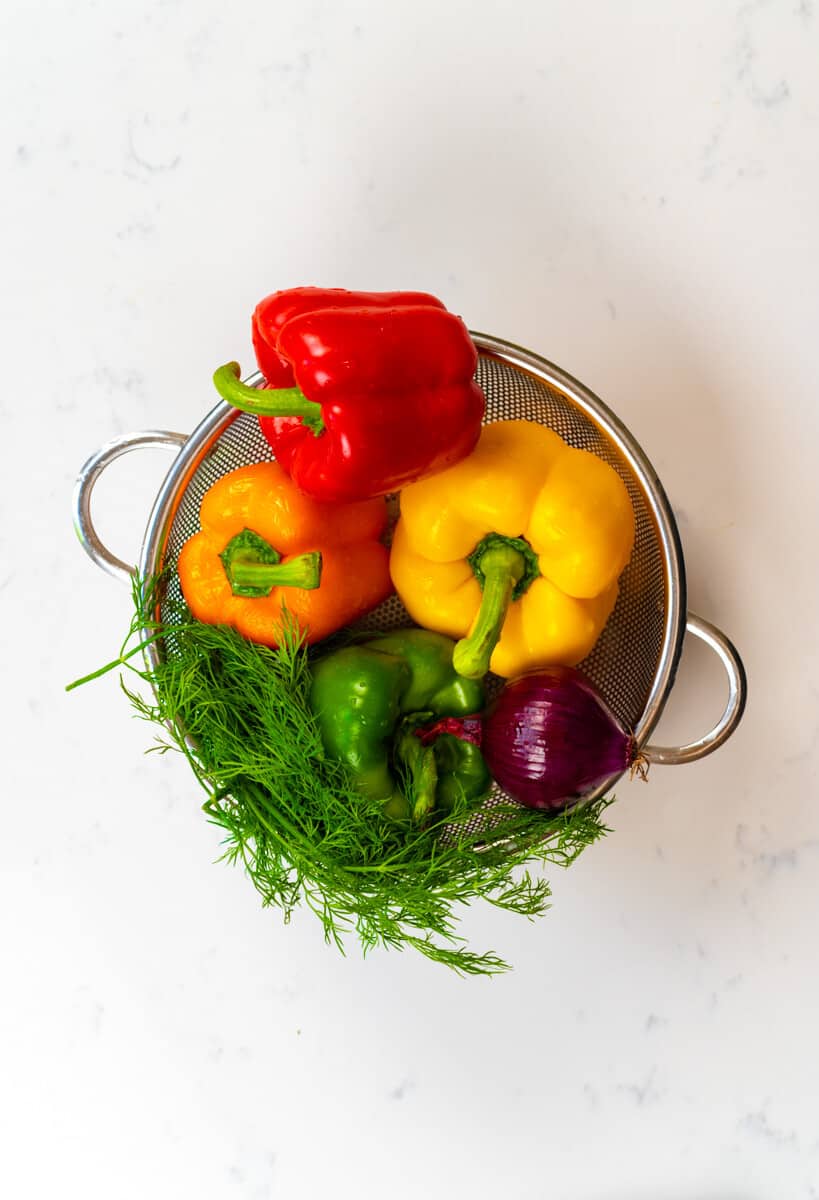
- Mushrooms
- Leek
- Courgette
- Peppers: green bell pepper, red bell pepper, orange bell pepper, yellow bell pepper, capsicum, chili peppers, etc.
- Tomato
- Onion
- Potatoes
- Asparagus
- Sweetcorn
- Olives
- Broccoli
- Brussel sprouts (no really, it’s good!)
- Butternut squash
- Carrot
- Aubergine
- Spinach
- Kale
- Peas
You also have a variety of herbs & spices you can add, including (just to name a few):
- Ginger
- Garlic/scallions/shallots
- Parsley
- Rosemary
- Basil
- Cilantro
- Chives
- Dill
- paprika
- Cayenne pepper (for some heat)
And you can, of course, also add a cheeky serving of cheese with all your veggies, too. Crumble over feta for salty tang, or simply sprinkle over mozzarella, cheddar, etc.
How To Make An Omelette
For this veggie omelet, I’ll be using a number of bell peppers and some onion as my veggie filling. However, you can also add/swap out veggies for your own favorites. They will likely need a similar process, i.e., a few minutes of sautéing.
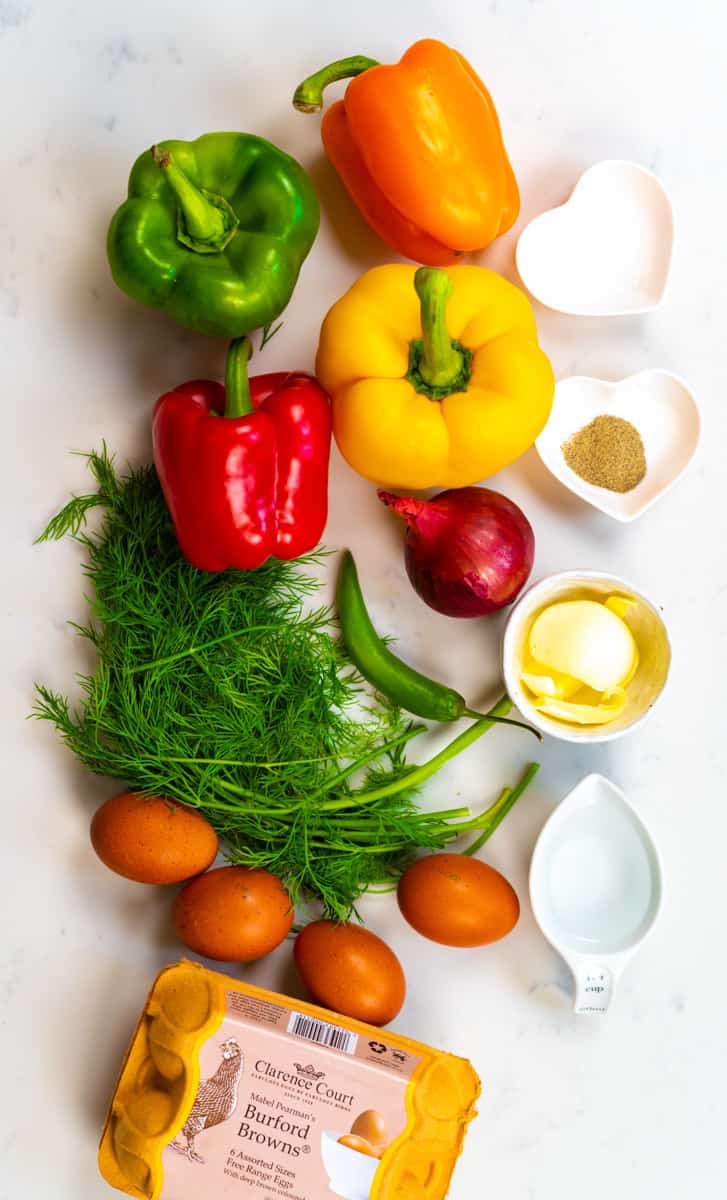
I’ll also be giving you three options on how to ‘fill’ and ‘finish’ your healthy omelette, and what the difference is. That way you can decide exactly which works best for you.
Chop your veggies. Depending on what way you plan to ‘finish’ off your omelette (read the section below), you may need smaller pieces vs. larger. I like mine finely chopped.
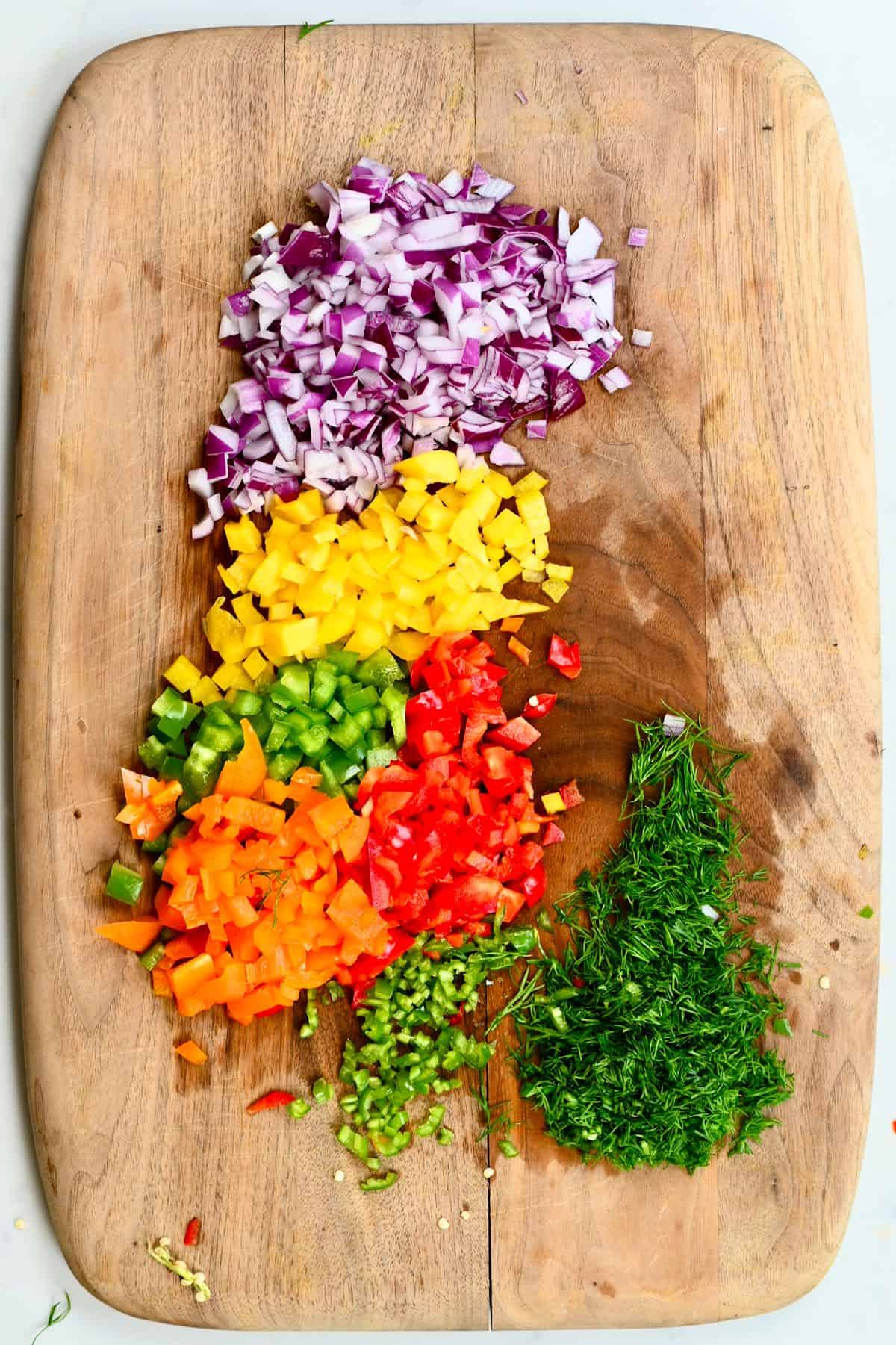
Then, whisk the eggs with the water and spices until you achieve a uniform mixture. Also finely chop the dill. I usually use scissors to cut any fine herbs, and it makes the job SO much faster.
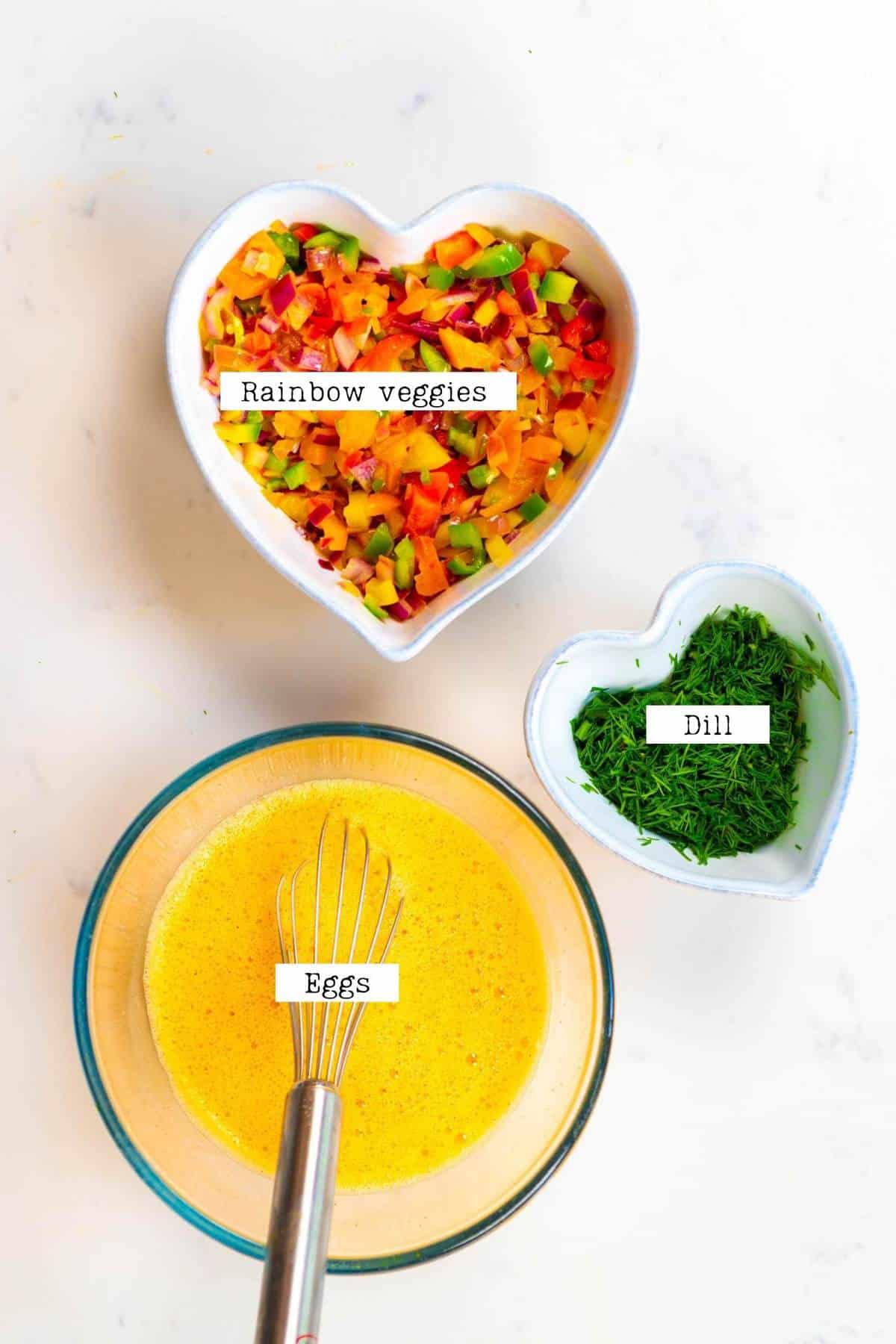
Next, add the chopped dill and whisk until incorporated.
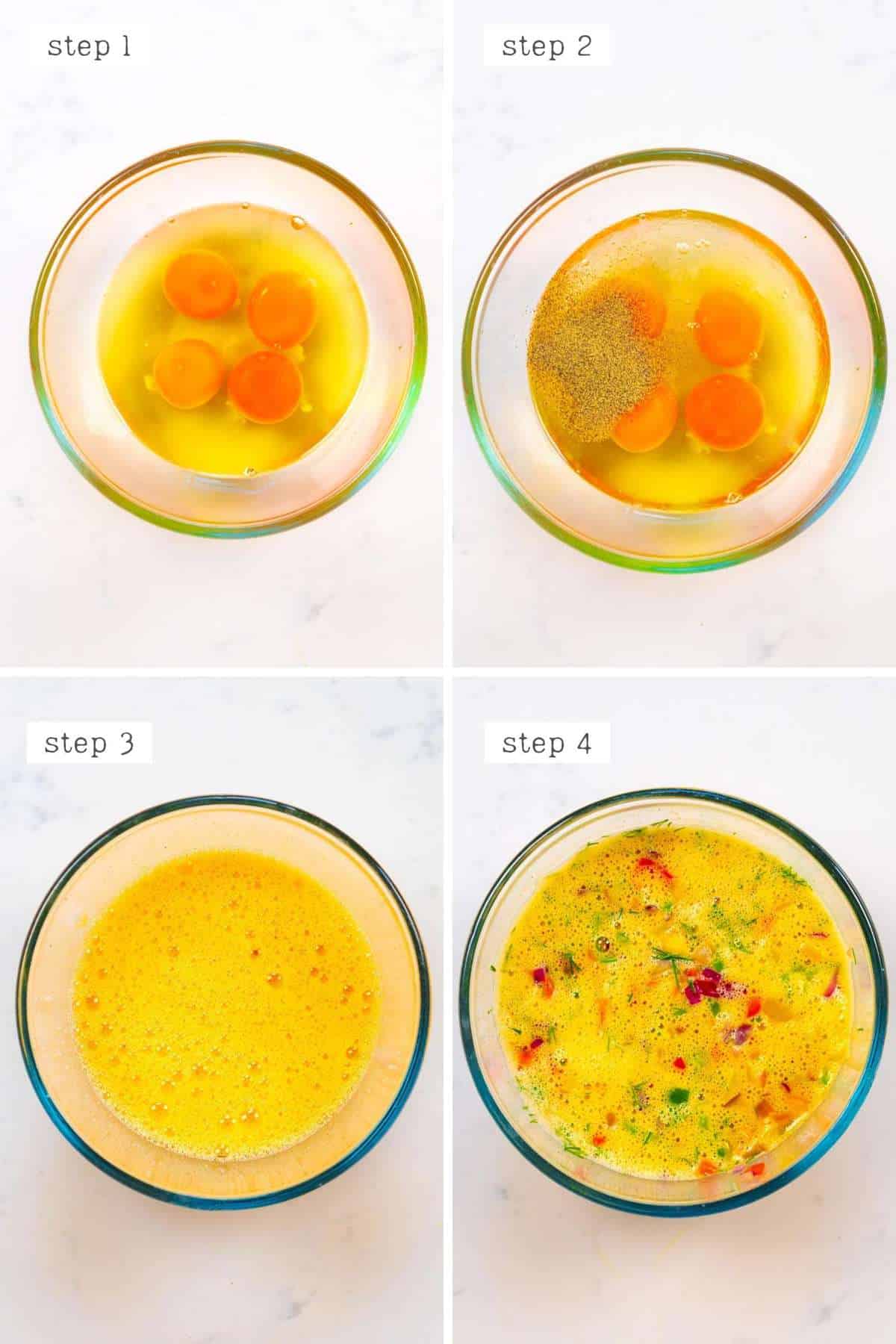
Heat up the butter in a large non-stick frying pan/skillet. For a single-serve omelette then a 6-inch pan will be more than enough. For two servings, then between an 8-10-inch pan.
Finely dice your onion and add it to the pan. Lightly sauté on medium heat for about a minute, then add in the remainder of the vegetables.
Sauté the vegetables for just a few minutes, until they begin to soften. At this point, you could add some additional seasonings to the vegetables, if you prefer (like salt & pepper, cayenne, paprika, turmeric, etc.).
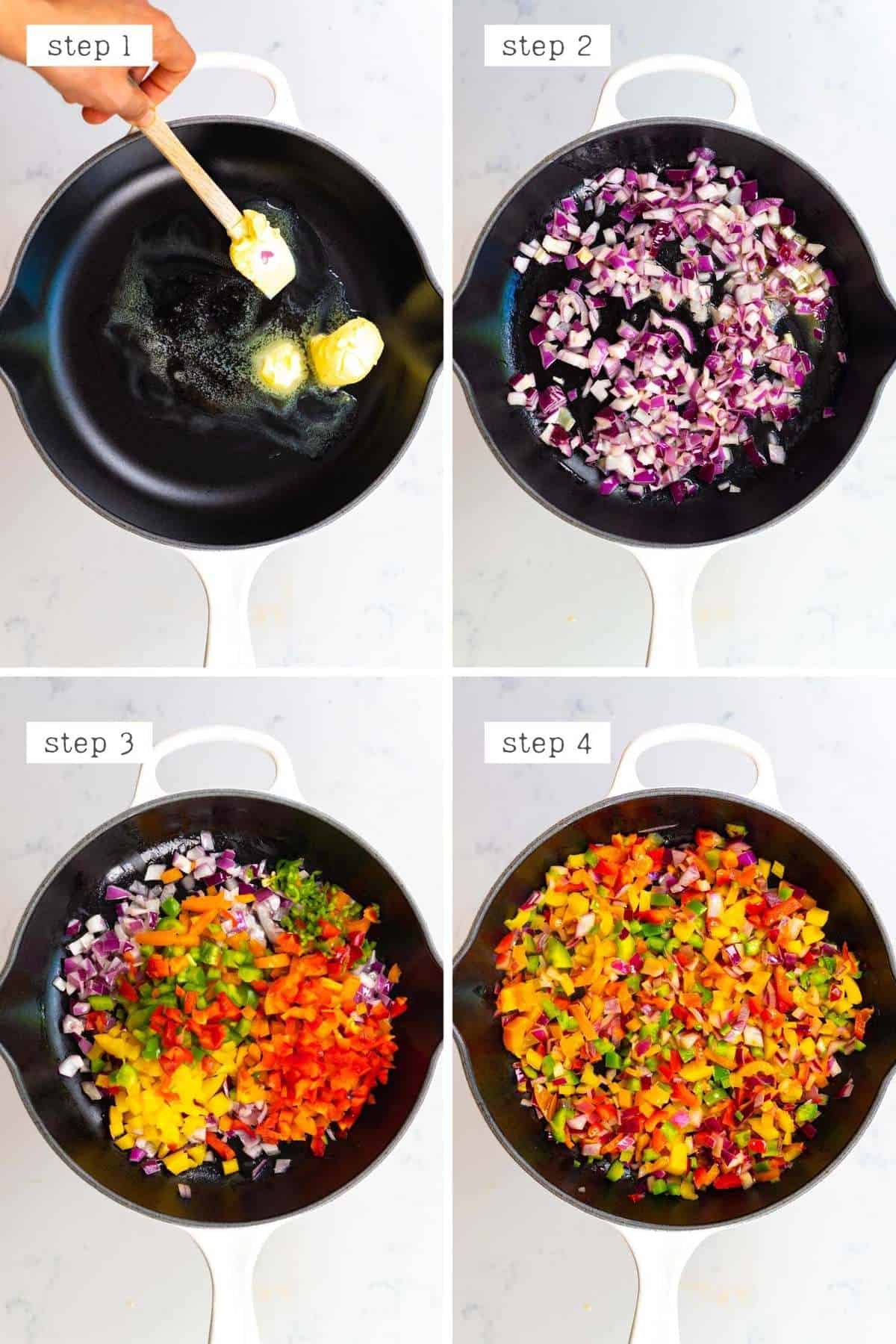
Reduce the heat to low and pour in the egg mixture. Allow it to sit for just a few seconds to firm up, give the pan a little shake to dispense the egg on top, and then using a small rubber spatula gently push/gently fold the egg away from the sides.
Tilt the pan slightly and allow excess egg to flow into the corners. This way all the uncooked eggs will move to the sides, and your omelette will cook faster. You want your omelette to be vibrant and fluffy but without overcooking the eggs.

As an optional step, you could place a lid over the omelette for a couple of minutes. This will allow the water in the egg mixture to steam up further and help cook the top of the eggs even faster.
Just before it’s served, sprinkle with salt and pepper and then serve immediately. I usually shake the pan a bit to make sure the egg mixture is loose and then, holding a plate below the pan, tilt the pan and allow it to slowly slide onto the plate.
How To Fill & Finish
Method One: Once your vegetables are sautéed, simply pour the egg mixture over the vegetables, for an incorporated vegetable omelette. This method requires smaller bits of vegetables and ‘less’ vegetables. Otherwise, you run the risk of being unable to flip or move it without breakage. This is the method I’ve outlined above.
Method Two: After the vegetables are softened, remove them from the pan. Place a little more oil/butter in the pan and pour in the egg mixture (tilting, to add the extra eggs to the sides, as it cooks). When it is 3/4 of the way cooked, then just spoon the veggies back over the omelette. For a folded omelette, put the veggies on one half of the omelette, and then fold it in half. After a minute or two, and flip the folded omelette and cook for another minute. That way, the inside of the omelette should be thoroughly cooked, too.
Method Three: Finally, the grill/broiler method. This method requires absolutely no flipping or extra effort on your part. After your veggies are soft, remove them from the pan. Add the eggs to the pan (and tilt, as usual) and cook around 1/2 way before spooning the vegetables back over the top.
That will allow the bottom to be cooked, so the veggies don’t break through the omelette. You then simply sprinkle the omelette with cheese, if wanted, and place under a grill (or broiler in America) until golden on top. This method is great for if you REALLY want to pack a lot of veggies onto your omelette – plus, the broiling/grilling somehow puffs up the omelette too.
How To Serve
Omelettes are best served immediately. You can have the omelette as-is for a light meal. Or serve it alongside some ‘side dishes.’
I love to pair veggie omelettes with salads. For example, this Easy Potato Salad With Egg (Mashed Potato Salad), or Simple Traditional Lebanese Fattoush Salad.
I also love to serve them as part of a large brunch table. Serve alongside French Toast, protein waffles, and even shakshuka or this tomato egg recipe.
If you give this healthy veggie omelette recipe a go, then let me know your thoughts in the comments. Also, feel free to tag me in you recreations @AlphaFoodie.

Vegetable Omelette
Ingredients
- 4 eggs I used Clarence Court Burford Brown Eggs
- ¼ cup water
- 0.7 oz dill
- 2 Tbsp butter unsalted
- ¼ red pepper finely diced
- ¼ yellow pepper finely diced
- ¼ orange pepper finely diced
- 1 red onion small
- 1 jalapeno pepper optional
- ½ tsp salt
- ¼ tsp black pepper
Instructions
- Whisk the eggs with the water until you achieve a uniform mixture.
- Add the chopped dill and whisk until incorporated. I usually use scissors to cut any fine herbs, and it makes the job SO much faster.
- Chop your veggies. Depending on what way you plan to 'finish' off your omelette (read the section below), you may need smaller pieces vs. larger.
- Heat up the butter in a large non-stick frying pan/skillet. For a single-serve omelette then a 6-inch pan will be more than enough. For two servings, then between an 8-10-inch pan.
- Finely dice your onion and add it to the pan. Lightly saute on medium heat for about a minute, then add in the remainder of the vegetables.
- Saute the vegetables for just a few minutes, until they begin to soften. At this point, you could add some additional seasonings to the vegetables, if you prefer (like salt & pepper, cayenne, paprika, turmeric, etc.).
- Reduce the heat to low and pour in the egg mixture. Allow it to sit for just a few seconds to firm up, give the pan a little shake to dispense the egg on top, and then using a small rubber spatula gently push/gently fold the egg away from the sides.
- Tilt the pan slightly and allow excess egg to flow into the corners. This way all the uncooked eggs will move to the sides, and your omelette will cook faster. You want your omelette to be vibrant and fluffy but without overcooking the eggs.
- As an optional step, you could place a lid over the omelette for a couple of minutes. This will allow the water in the egg mixture to steam up further and help cook the top of the eggs even faster.
- Just before it's served, sprinkle with salt and pepper and then serve immediately. I usually shake the pan a bit to make sure the egg mixture is loose and then, holding a plate below the pan, tilt the pan and allow it to slowly slide onto the plate.
Video
Notes
- The key to making an omelette that’s super easy to make. Use a good non-stick pan!
- If you want to make an egg-white omelette, separate the egg whites from the yolks, and follow the same steps. This will be a little more fiddly, though, and more prone to stick to the pan.
- Make sure to use a low-medium heat. Otherwise, you can end up cooking the eggs with a burnt bottom and raw top/done top. This lower heat allows the eggs to cook all the way through. Especially important if you don’t intend to ‘flip’ the omelette at all.
- It’s best to stick to between 1/3-1/2 cup of vegetables per 2-egg omelette. This reduces the risk of a ‘scrambled egg’ mishap. Unless you use the third method of ‘finishing’ off your omelette, in which case it seems to be able to handle A LOT more.
- You can use a different oil, but butter is by far the most flavorful, best option for rich results, in my opinion.
- When making a pepper-based veggie omelette as I did, you could even cook the peppers in a little ‘fajita’ seasoning, for a ‘fajita’ omelette.
- If you are using method one of filling your veggie omelet and want to add even more veggies then you can keep some extra cooked veggies to one side to top it with after cooked.
Nutrition
Nutrition information is automatically calculated, so should only be used as an approximation.





















I make omlette adding water for so many years. For one egg i add 1/2 eggshell of water. Its very light and soft texture
Thanks for sharing, Renuka. Indeed, adding water makes the texture so light and soft.